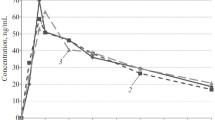Summary
The inhibition of monoamine oxidase (MAO) by tranylcypromine was studied in 6 healthy volunteers given increasing doses of 10, 15, 20 and 25 mg/day over a 4 week period. Measurements were made of urinary tryptamine excretion, blood pressure response to tyramine (TY) and norepinephrine (NE), and subjective self-rating. A significant increase in urinary tryptamine, indicating the onset of MAO inhibition, occurred in all 6 subjects once the cumulative dose of 40 mg TC had been administered. Thereafter, urinary tryptamine increased up to 7-fold, dose-dependently with large interindividual variation (78±27 to 549±252 µg/g creatinine). Within 4 days after stopping the drug, control values were reached again. The assessment of TY potentiation by comparison of equieffective doses (Sdose) became up to 10 times more sensitive when both the height and the duration of the increase in systolic blood pressure (SAUC) were taken into account. The increases in tyramine sensitivity found with the highest cumulative doses of TC (5.4±0.8 mg/kg; n=6) were Sdose from 8–16 and SAUC from 28–162, respectively. The pharmacodynamic half-life (Pd1/2) of TC approximated a mean first fast Pd1/2 of 1.3 d and a slower phase of 14.2 d. During treatment with the highest TC dose, resting blood pressure was significantly elevated from 120 to 128 mm Hg, and the pressor sensitivity to NE (SNE) in 4 of the 6 subjects rose, the mean was 1.7 (n=6). In 3 volunteers NE sensitivity was normalized within 4 days after stopping TC. There was a significant correlation between increasing vigilance with TC dose in 5 volunteers (r=0.81, n=15, p<0.01). It is concluded that combination of the results of several tests has provided reliable information about the onset, extent and duration of MAO inhibition in healthy volunteers.
Similar content being viewed by others
References
Atkinson RM, Ditman KS (1965) Tranylcypromine: a review. Clin Pharmacol Ther 6: 631–655
Baldessarini RJ (1980) Drugs and the treatment of psychiatric disorders. In: Goodman LS, Gilman AG (eds) The pharmacological basis of therapeutics, 6th ed. MacMillan, New York
Bieck PR, Antonin K-H (1981) Time course of monoamine oxidase inhibition by tranylcypromine (TC): using the blood pressure responses to tyramine (TY) and norepinephrine (NE). Naunyn Schmiedebergs Arch Pharmacol 316:[Suppl] R 78
Carruthers SG, Hosler JP, Pentikainen P, Azarnoff, DL (1978) Pamatolol: Phase I evaluation of the pharmacodynamics of a cardioselective beta adrenoceptor blocking drug. Clin Pharmacol Ther 24: 168–174
Cavanaugh JH, Griffith JD, Oates JA (1970) Effect of amphetamine on the pressor response to tyramine: Formation of p-hydroxynorepinephrine from amphetamine in man. Clin Pharmacol Ther 11: 656–664
Demet EM, Halaris AE (1979) Origin and distribution of 3-methoxy-4-hydroxyphenylglycol in body fluids. Biochem Pharmacol 28: 3043–3050
Eysenck HJ (1959) MPI. Hogrefe, Göttingen
Ghose K (1980) Biochemical assessment of antidepressive drugs. Br J Clin Pharmacol 10: 539–550
Ghose K (1980) Assessment of peripheral adrenergic activity and its interactions with drugs in man. Eur J Clin Pharmacol 17: 233–238
Janke W (1980) Psychometric and psychophysiological actions of antipsychotics in men. In: Hoffmeister F, Stille G (eds) Handbook of experimental pharmacology, vol 55/I. Springer, Berlin Heidelberg New York
Kinross-Wright JV (1959) Discussion of paper by Pomerange J: Experience with JB-516 and other psychochemicals. Ann NY Acad Sci 80: 840
Knoll J (1980) Monoamine oxidase inhibitors: Chemistry and pharmacology. In: Sandler M (ed) Enzyme inhibitors as drugs. MacMillan, London, pp 151–171
Lang A, Geißler HE, Mutschler E (1979) Bestimmung und Vergleich der Plasma- und Urinkonzentrationen nach Gabe von(+)- und (−)-Tranylcypromin. Drug Res 29: 154–157
Levine RJ, Sjoerdsma A (1962) Direct measurement of monoamine oxidase inhibition in humans. Clin Pharmacol Ther 4: 22–27
Möhrke W: priv. commun.
Palm D, Fengler HJ, Güllner HG, Planz G, Quiring K, May B, Helmstaedt D, Lemmer B, Moon HK, Holler CH (1971) Quantitation of irreversible inhibition of monoamine oxidase in man. Eur J Clin Pharmacol 3: 82–92
Peet M, Ellis S, Yates RA (1981) The effect of level of depression on the use of visual analogue scales by normal volunteers. Br J Clin Pharmacol 12: 171–178
Pettinger WA, Soyangco FG, Oates JA (1968) Inhibition of monoamine oxidase in man by furazolidone. Clin Pharmacol Ther 9: 442–447
Raese J, Schmiedek P, Ehrlich E (1974) Über den Ursprung der Homovanillinsäure im Urin. Arzneim Forsch 24: 1088–1093
Reynolds GP, Rausch ED, Riederer P (1980) Effects of tranylcypromine stereoisomers on monoamine oxidation in man. Br J Clin Pharmacol 9: 521–523
Riederer P, Reynolds GP, Youdim MBH (1981) Selectivity of MAO inhibitors in human brain and their clinical consequences. In: Youdim MBH, Paykel ES (eds) Monoamine oxidase inhibitors — the state of the art. John Wiley, New York, Ltd, pp 63–76
Robinson DS, Lovenberg W, Keiser H, Sjoerdsma A (1968) Effect of drugs on human blood platelet and plasma amine oxidase activity in vitro and in vivo. Biochem Pharmacol 17: 109–119
Rodnight R (1961) Body fluid indoles in mental illness. Int Rev Neurobiol 3: 263
Sjoerdsma A, Oates JA, Zaltzman P, Udenfriend S (1959) Identification and assay of urinary tryptamine: application as an index of monoamine oxidase inhibition in man. J Pharmacol Exp Ther 126: 217–222
Squires RF (1972) Multiple forms of monoamine oxidase in intact mitochondria as characterised by selective inhibitors and thermal stability: a comparison of eight mammalian species. Adv Biochem Psychopharmacol 5: 355–370
Author information
Authors and Affiliations
Additional information
Prof. Dr. med. H.-J. Kuschke dedicated to his 60th birthday
Rights and permissions
About this article
Cite this article
Bieck, P.R., Antonin, K.H. Monoamine oxidase inhibition by tranylcypromine: Assessment in human volunteers. Eur J Clin Pharmacol 22, 301–308 (1982). https://doi.org/10.1007/BF00548397
Received:
Revised:
Accepted:
Issue Date:
DOI: https://doi.org/10.1007/BF00548397




